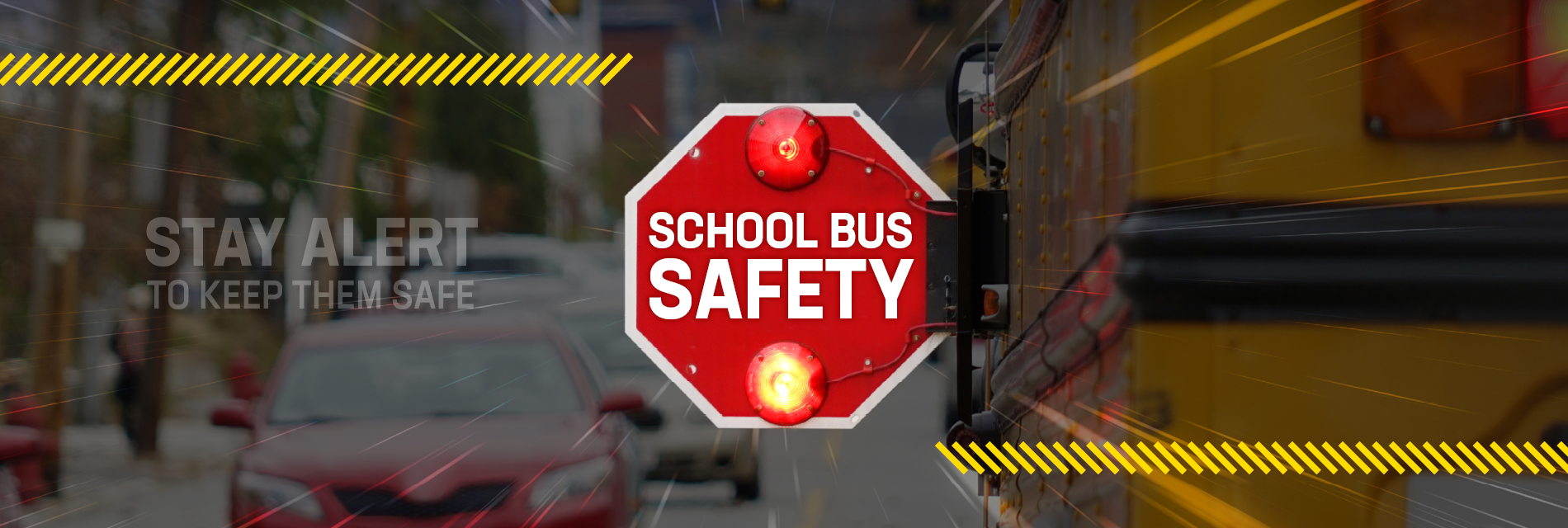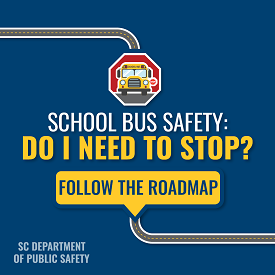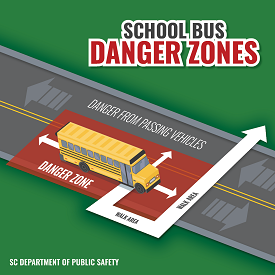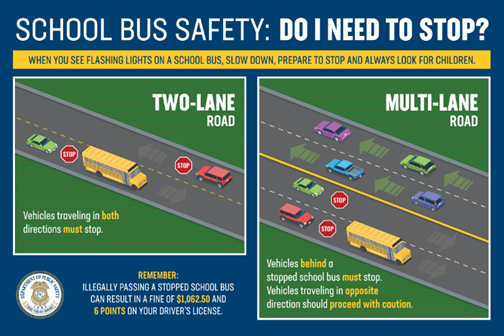
The beginning of the school year is a time when children are at an increased risk of transportation-related injuries from pedestrian, bicycle, school bus, and motor vehicle crashes. This is because there is more traffic on the roads each morning and afternoon, and the increased traffic causes many drivers to change their driving patterns.
To help keep kids safe, the South Carolina Department of Public Safety encourages parents and teachers to talk with their children about the importance of safety before and after school starts. The back-to-school season is a great time to teach, motivate, practice, and encourage safety habits as students travel to and from school.
Parents, students, schools, childcare facilities, and others should take advantage of the information offered here, including our safety videos, fun activity sheets, and educational materials.
School Bus Laws in South Carolina
Passing a stopped school bus not only puts children in unnecessary danger — it’s against the law.
In South Carolina, you must always stop on any highway when you are behind a school bus with red flashing lights and the stop arm extended. You must not proceed until the red lights are no longer flashing and the bus begins to move again.
Violations of the South Carolina’s school bus law will be subject to a fine and points against your driver’s license.
Two-Lane Roads
A two-lane road is a highway or private road with two lanes, having only one traffic lane traveling in each direction. Roads with two lanes and a median separating the lanes are also classified as a two-lane road.
On any two-lane highway or road, all traffic must stop for a school bus that has activated the red flashing lights and remain stopped until the bus disables the red flashing lights. Traffic that is traveling in the same direction of the school bus must also not pass or overtake the bus once the flashing amber lights have been activated and remain stopped until the red flashing lights have been disabled.
After the red and/or amber lights on the school bus have stopped flashing and the stop arm is no longer visible, proceed slowly and watch for children.
Multi-Lane Roads
A multi-lane highway or multi-lane private road is a highway or private road with four or more lanes, having at least two traffic lanes traveling in one direction.
On any four-lane or multi-lane highway, ONLY drivers traveling in the SAME direction as the bus must stop for the entire time a school bus is stopped, preparing to stop with its red and amber lights flashing, or has its stop arm extended.
Vehicles approaching a stopped school bus on the opposite side of a multi-lane road may proceed with caution. This is because bus routes on these roads are designed so that students will not have to cross a multi-lane roadway.
Passenger Loading Zones
Drivers do not have to stop for a school bus when a school bus is in a passenger loading zone completely off the main travel lanes and when pedestrians are not allowed to cross the road. However, please stay alert for children and proceed with caution.
Read more about the state’s school bus laws in the South Carolina Code of Laws Section 56-5-2770.
Back to School Safety Tips
Whether school is in session or not, it is always a good time for everyone – motorists, parents, educators, and students – to review and improve their traffic safety practices. The following tips can help make this a safe and happy school year for the whole community.
Tips for Motorists
- When a school bus or children are present, slow down and proceed with caution.
- Obey all traffic laws and posted speed limits.
- Always stop for a school bus that has stopped to load or unload passengers. Red flashing lights and an extended stop arm tell you the school bus is stopped to load or unload children. Be alert and ready to stop.
- Watch for children walking in the street, especially where there are no sidewalks. Watch for children playing and gathering near bus stops. Watch for children arriving late for the bus, who may dart into the street without looking for traffic.
- When backing out of a driveway or leaving a garage, watch for children walking or biking to school.
- When driving in neighborhoods or school zones, watch for young people who may be in a hurry to get to school and may not be thinking about getting there safely.
Tips for Parents
- Help your children learn and practice the safety rules for walking, cycling, or riding in a passenger car, school bus, or transit bus.
- Supervise young children as they are walking or biking to school or as they wait at the school bus stop.
- Be a good role model, especially when you are with your kids. Always buckle up in the car, always wear a helmet when biking, and always follow pedestrian safety rules.
Tips for Students
- Always buckle up when you are riding in a car.
- Always ride in the back seat. It is the safest place for young people.
- If you ride a bike, always wear a helmet and follow traffic safety rules.
- If you ride a school bus, learn and practice the safety rules for waiting at the bus stop, getting on and off the bus, and riding the bus.
- If you walk to school, learn and practice the safety rules for pedestrians. Always cross at cross walks and obey all traffic signs, traffic lights, and safety patrol instructions.
- Be a good role model for your younger siblings and friends, and help them learn and practice the safety rules.
Child Pedestrian Safety
Each year, many children are tragically injured or killed when they suddenly dart into the path of a car. This is because children move quickly and are often unaware of danger.
Here are some facts you should know:
- Most young children are injured near their home or on their own street.
- Most crashes involving young children occur between 3 p.m. and 6 p.m.
- Most crashes involving young children occur in fair and warm weather.
- Twice as many young boys are injured as young girls.
If you are a parent or caregiver, take time to educate your children on how to be safe pedestrians BEFORE tragedy happens.
Here are a few tips to help you teach children how to walk and cross the street safely:
- Supervise young children at all times — Young children should not be allowed to cross the street alone. Teach them who can help them cross the street safely.
- Teach by explaining — Explain to your child the safe way you cross the street. Say, “When I cross a street, I always stop at the curb. I look for cars. I look left for any traffic coming, and then I look right for traffic coming that way. Then I look left again. When it is clear, I cross the street and keep looking left and right.”
- Teach by example — When you cross a street with your child, always:
- Stop at the curb.
- Look left, right, then left for traffic in all directions.
- Cross when it is clear.
- Keep looking for vehicles as you cross.
- Encourage your child — As you both safely cross the street together, praise your child for copying your safe actions and words. Practice what you teach at all times!
Spread the Word



